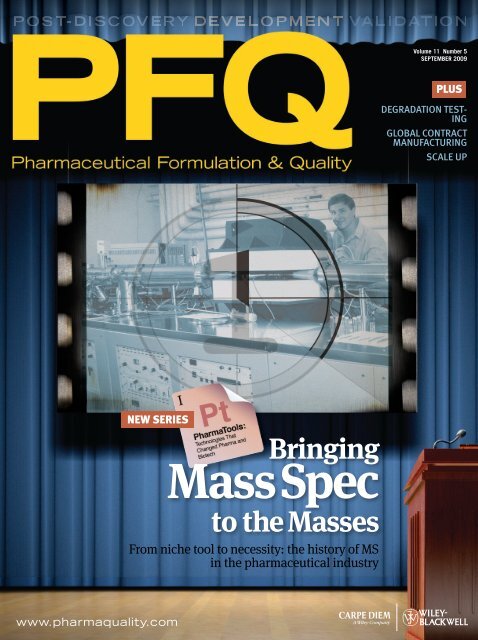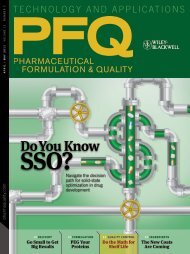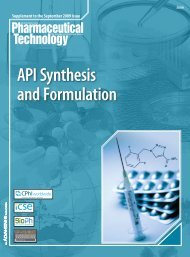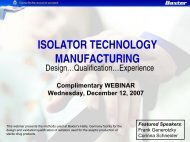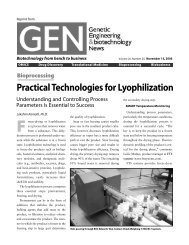The Keys to RTU Parenterals - Sterile Parenteral Drug Contract ...
The Keys to RTU Parenterals - Sterile Parenteral Drug Contract ...
The Keys to RTU Parenterals - Sterile Parenteral Drug Contract ...
- No tags were found...
You also want an ePaper? Increase the reach of your titles
YUMPU automatically turns print PDFs into web optimized ePapers that Google loves.
Volume 11 Number 5SEPTEMBER 2009PLUSDEGRADATION TEST-INGGLOBAL CONTRACTMANUFACTURINGSCALE UPNEW SERIESBringingMassSpec<strong>to</strong> the MassesFrom niche <strong>to</strong>ol <strong>to</strong> necessity: the his<strong>to</strong>ry of MSin the pharmaceutical industrywww.pharmaquality.com
Formulation<strong>RTU</strong> DRUG PRODUCTS<strong>The</strong> <strong>Keys</strong> <strong>to</strong> <strong>RTU</strong> <strong><strong>Parenteral</strong>s</strong><strong>The</strong>re are a number of challenges when it comes <strong>to</strong>ready-<strong>to</strong>-use products | BY PAULA YOUNGBERG WEBB, MS, ANDRAO CHILAMKURTI, PHDEdi<strong>to</strong>r’s Note: This is the first in a three-part series on ready-<strong>to</strong>-use parenteral products. Part two willappear in our Oc<strong>to</strong>ber/November issue.Many parenteral drug products are administered as intravenous (IV) infusionsin multiple-patient care settings, from hospitals <strong>to</strong> alternate carefacilities. <strong>The</strong> drug product, typically packaged in a vial or ampoule, isadded <strong>to</strong> an IV solution such as normal saline or 5% dextrose prior <strong>to</strong> intravenousinfusion. Several drugs for IV infusion, premixed in an intravenous diluent,are also commercially available. <strong>The</strong>se products are referred <strong>to</strong> as ready-<strong>to</strong>-use (<strong>RTU</strong>)products or “premix” drug solutions. Examples of commercially available <strong>RTU</strong> drugproducts are listed in Table 1 (see p. 41).<strong>The</strong>re are a number of key fac<strong>to</strong>rs in the development of <strong>RTU</strong> parenteral products.In addition <strong>to</strong> container selection and optimization of formulation for drug stability,other key considerations include analytical method development, manufacturingprocess development and tech transfer, and stability testing programs for registrationbatches.All About <strong>RTU</strong>sLike most IV infusion solutions, <strong>RTU</strong> drug products for IV infusion are packaged inflexible plastic containers; however, some drugs that adsorb <strong>to</strong> plastic materials, suchas nitroglycerin, may be packaged in glass containers. Flexible plastic containers offerseveral advantages over glass infusion bottles with respect <strong>to</strong> safety, handling, s<strong>to</strong>rage,and so on. Solution volumes of <strong>RTU</strong> drug products for IV infusion typically rangefrom 50 mL <strong>to</strong> 1 L.Depending on the stability of a drug, these products may be terminally sterilized,aseptically filled, or aseptically filled and frozen. <strong>The</strong>se frozen products are distributedand s<strong>to</strong>red in a frozen state and thawed prior <strong>to</strong> use. <strong>The</strong>y are given a long-termFigure 1. Categories of <strong>Parenteral</strong> <strong>RTU</strong> <strong>Drug</strong> Solutions For IV Infusionshelf life in a frozen state and a thawedshelf life at room or refrigerated temperature.Figure 1 (see below) depicts varioustypes of parenteral <strong>RTU</strong> products basedon type of container and manufacturingprocess.<strong>Parenteral</strong> <strong>RTU</strong> products for IV infusionoffer many benefits compared <strong>to</strong>admixed IV drugs. One of the primarybenefits is elimination of complex proceduresrequired for traditional IV admixtureand compounding, saving both timeand labor. <strong>The</strong> use of <strong>RTU</strong> drug productsin hospitals allows the pharmacist <strong>to</strong> allocatemore time <strong>to</strong> clinical and other activities.<strong>The</strong>se products also help <strong>to</strong> improvecompliance with patient safety guidelinesand reduce the risk of medicationerrors, medication contamination, andneedle stick infections. Additionally, theyhelp pharmacists <strong>to</strong> comply with stringentJoint Commission on the Accreditationof Healthcare Organizations and U.S.Pharmacopeia 797 guidelines.<strong>The</strong> formulations of liquid <strong>RTU</strong> productsare optimized for stability in the chosenIV diluent, which results in a longershelf life than the “beyond use date” forcompounded solutions. <strong>The</strong> formulationof frozen <strong>RTU</strong> products is also optimizedfor long-term stability during frozen s<strong>to</strong>rageand short-term stability after thawing.Due <strong>to</strong> formulation optimization, thethawed shelf lives of frozen <strong>RTU</strong> productsare often longer than the “beyond usedate” of compounded solutions. <strong>The</strong>longer thawed shelf lives allow the pharmacist<strong>to</strong> recycle the unused product(products not administered <strong>to</strong> any patient)for use at a later time. <strong>The</strong> <strong>RTU</strong> drugproducts are generally iso-osmotic due <strong>to</strong>the ability of the manufacturer <strong>to</strong> adjustthe concentration of the <strong>to</strong>nicity agent,such as dextrose.Formulation and ContainerSelectionSeveral fac<strong>to</strong>rs, including clinical, formulation,container, and marketing, play akey role in selecting a parenteral drug <strong>to</strong>P FQwww.pharmaquality.com
e developed as an <strong>RTU</strong> product. Becausethe <strong>RTU</strong> products typically deliver a unitdose, the dosing regimen for candidatedrugs involves a fixed standard dose; thedrugs are administered with an IV diluentsuch as sodium chloride injection, dextroseinjection, or lactated ringers injection.<strong>The</strong> type of diluent selected oftendepends upon clinical considerationssuch as sodium or electrolyte levels andlimitations on carbohydrate intake (suchas dextrose for the diabetic patient population).<strong>The</strong> solution volume of the productselected also depends upon the recommendedrate of infusion for a specificdrug. Injection site interactions such aspain or erythema, along with limitationson fluid intake, are also considerations inselecting the solution volume. In addition<strong>to</strong> these clinical considerations, the benefitsof <strong>RTU</strong> drug products for infusion overthe traditionally compounded drug admixturesplay a major role in the decision<strong>to</strong> develop and market an IV drug for infusionas a <strong>RTU</strong> product.Key considerations in selecting a containersystem for an intravenous <strong>RTU</strong> productinclude drug-container compatibility,protection of drug from external elements,safety profile, and functional performance.Adsorption of drug <strong>to</strong> plastic film orabsorption, particularly during au<strong>to</strong>clavesterilization, must be considered as a par<strong>to</strong>f compatibility. A pH change in solutiondue <strong>to</strong> leaching of plastic excipients isanother important fac<strong>to</strong>r; pH change mayresult in increased drug degradation ordrug precipitation. Leached extractablesmay also precipitate in solution in thepresence of certain drugs or may causethe drug <strong>to</strong> precipitate.<strong>The</strong> chosen container system shouldprotect the drug from light and oxygen, ifnecessary, and should have low water vaportransmission <strong>to</strong> ensure minimumwater loss. Water loss from flexible plasticcontainers may affect delivered volumeand may also result in increased concentrationof drug in the solution over time.<strong>The</strong> selected container system must alsoact as a barrier <strong>to</strong> microbial ingress. Itmust pass biological testing and <strong>to</strong>xicologicalevaluation. Finally, the containersystem must exhibit relevant functionalperformance with respect <strong>to</strong> integrity, deliveryof dose, and rate of delivery.Figure 2. Effect of Formulation Fac<strong>to</strong>rs on <strong>Drug</strong> StabilityFormulation Development<strong>The</strong> primary purpose of formulation developmentis <strong>to</strong> achieve the desired stabilityand shelf life of the final productthrough optimization of various fac<strong>to</strong>rs affectingthe stability of the drug in aqueoussolutions. <strong>The</strong>se fac<strong>to</strong>rs, as depicted inFigure 2 (see above), include solution pH,buffer type and concentration if required,drug concentration, diluent type and concentration,oxygen, and light. For mostdrugs, stability in aqueous solutions is affectedby pH. <strong>The</strong>refore, a thorough understandingof the pH-rate profile is essential.If the solution pH cannot be maintainedwithin the optimal range, a bufferthat is suitable for IV administration canbe added. However, the type of buffer selecteddepends upon the formulation pHand the dissociation constants of thebuffer <strong>to</strong> achieve the desired level ofbuffering capacity. <strong>The</strong> amount of bufferadded must be optimized <strong>to</strong> ensure maintenanceof pH and <strong>to</strong> minimize buffercatalysis. In addition, the amount/concentrationof buffer must be acceptablefrom a <strong>to</strong>xicological perspective. In someinstances, different concentrations of adrug may show different rates of degradationdue <strong>to</strong> self-association.<strong>The</strong> type of diluent that is added <strong>to</strong>the formulation—sodium chloride or dextrose,for example—may also play a rolein the degradation of a drug. Addition ofsodium chloride may result in increasedionic strength, which may alter the degradationrate or cause potential precipitationof drug. Stability of certain drugs canalso be affected by the presence of carbohydrateslike dextrose. Finally, oxygen andlight may play a significant role in drug stability.<strong>The</strong>se fac<strong>to</strong>rs can be controlled bythe use of an appropriate container systemand/or the addition of antioxidants.In general, due <strong>to</strong> phase changes tha<strong>to</strong>ccur upon freezing of a drug solution,formulation development and optimizationfor drug stability for frozen products ismore complicated than for those liquidformulations s<strong>to</strong>red at room temperature.When a drug solution is frozen, water crystallizesas ice, and the remaining solutionbecomes concentrated. At the intendedlong-term s<strong>to</strong>rage temperature, for example–20° C, the drug (and some excipients)may precipitate from the solution or remainin a concentrated state. Dependingon the temperature, it may also exist as aglassy state.(Continued on p. 42)Table 1. Examples of Commercially Available <strong>RTU</strong> <strong>Parenteral</strong> Products for IV InfusionSeptember 2009
FORMULATION<strong>RTU</strong> <strong>Drug</strong> ProductsTable 2. Example: Formulation Optimization - VariablesTable 3. Example: Formulation Optimization – Test IntervalsIf precipitation of drug occurs, the long-term stability of thedrug in the frozen state is much more enhanced than in the liquidstate. If the drug remains a concentrate, the degradation rate orkinetics could change relative <strong>to</strong> liquid state. Although the presenceof drug in glassy state may enhance the stability in comparison<strong>to</strong> a concentrate, the existence of drugs in a glassy state above–20°C is not common.In optimizing the drug formulations for stability, it is extremelyimportant <strong>to</strong> understand the effect of each formulationfac<strong>to</strong>r as well as combination effects. A multi-fac<strong>to</strong>rial design canbe utilized <strong>to</strong> understand these effects. Such studies will help <strong>to</strong>meet regula<strong>to</strong>ry requirements. 1Tables 2 and 3 (see left) illustrate an example of formulationoptimization design and relevant s<strong>to</strong>rage conditions <strong>to</strong> evaluatethese fac<strong>to</strong>rs. During the formulation studies, moni<strong>to</strong>ring andevaluation of impurities/degradation products is critical, becauseone or more impurities/degradation products may become thelimiting fac<strong>to</strong>rs for meeting overall specifications and achievingthe desired shelf life. <strong>The</strong>se studies will form the basis for qualificationof impurities as required by the ICH Q3B guideline. 2 In addition,pH, visual inspection, particulate matter, and color areessential parameters <strong>to</strong> be moni<strong>to</strong>red. nYoungberg Webb is senior direc<strong>to</strong>r of stability operations and Dr. Chilamkurti is seniordirec<strong>to</strong>r of pharmaceutical technology at Baxter Pharmaceuticals & Technologies. ReachDr. Chilamkurti at rao_chilamkurti@baxter.com.(Continued from p. 41)REFERENCES1. International Conference on Harmonisation of Technical Requirements forRegistration of Pharmaceuticals for Human Use (ICH). ICH Guideline Q 8(R1): Pharmaceutical development. Geneva, Switzerland; 2008.2. International Conference on Harmonisation of Technical Requirements forRegistration of Pharmaceuticals for Human Use (ICH). ICH Guideline Q 3 B(R2): Impurities in new drug products. Geneva, Switzerland; 2006.Reprinted with permission from PFQ Magazine September 2009.


